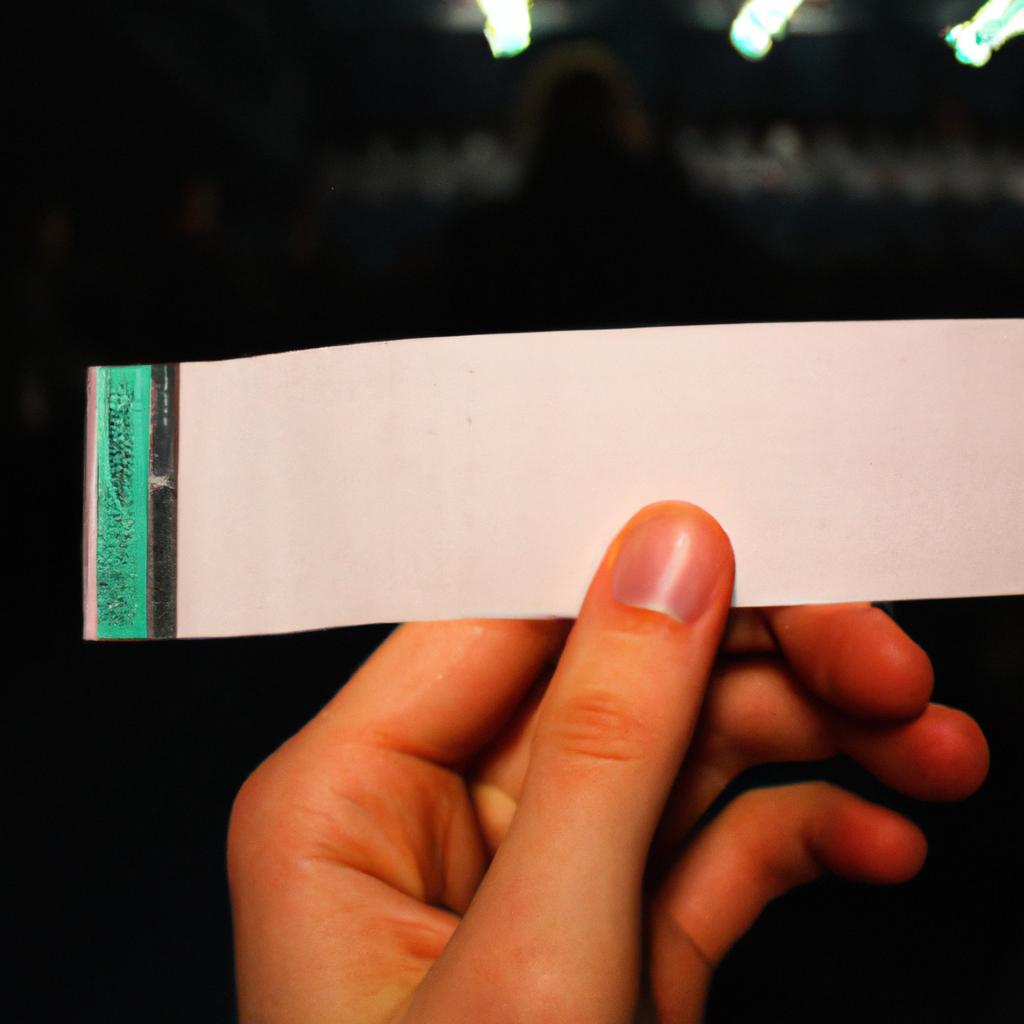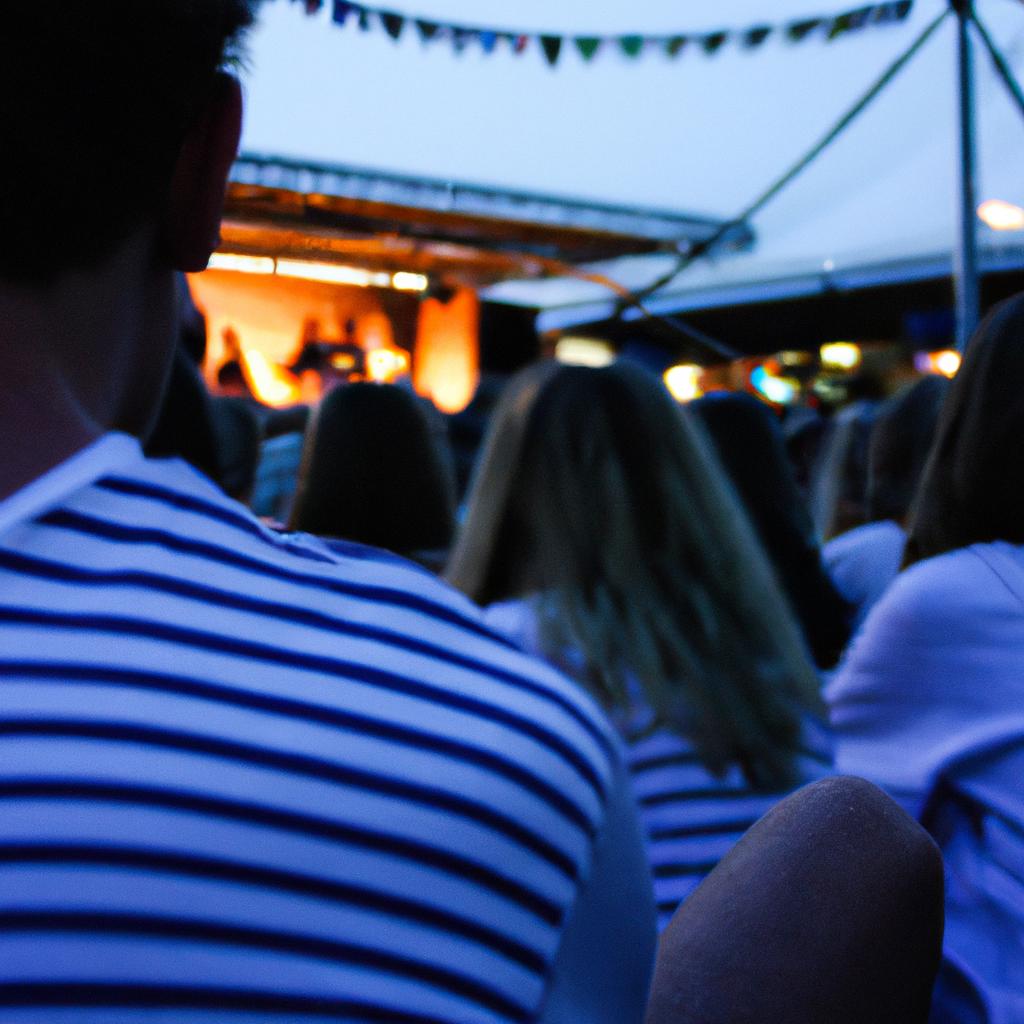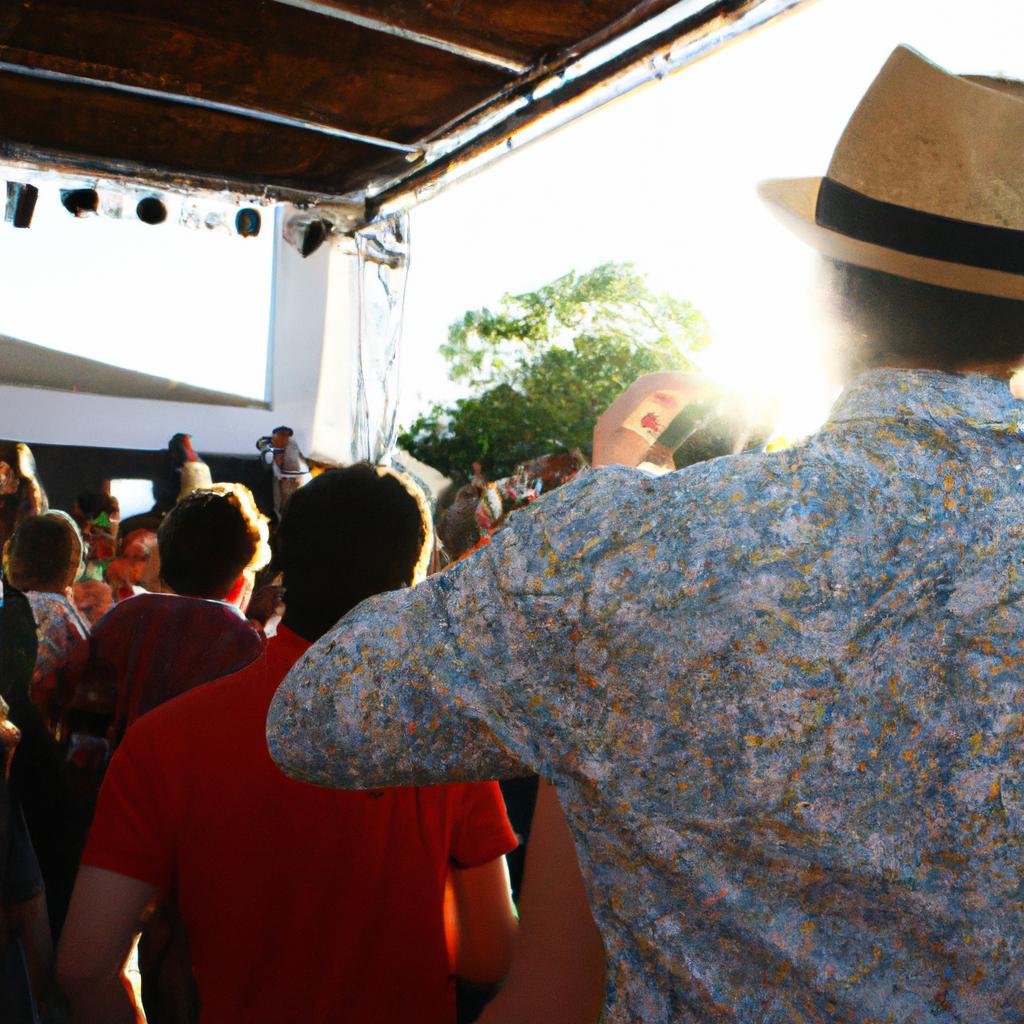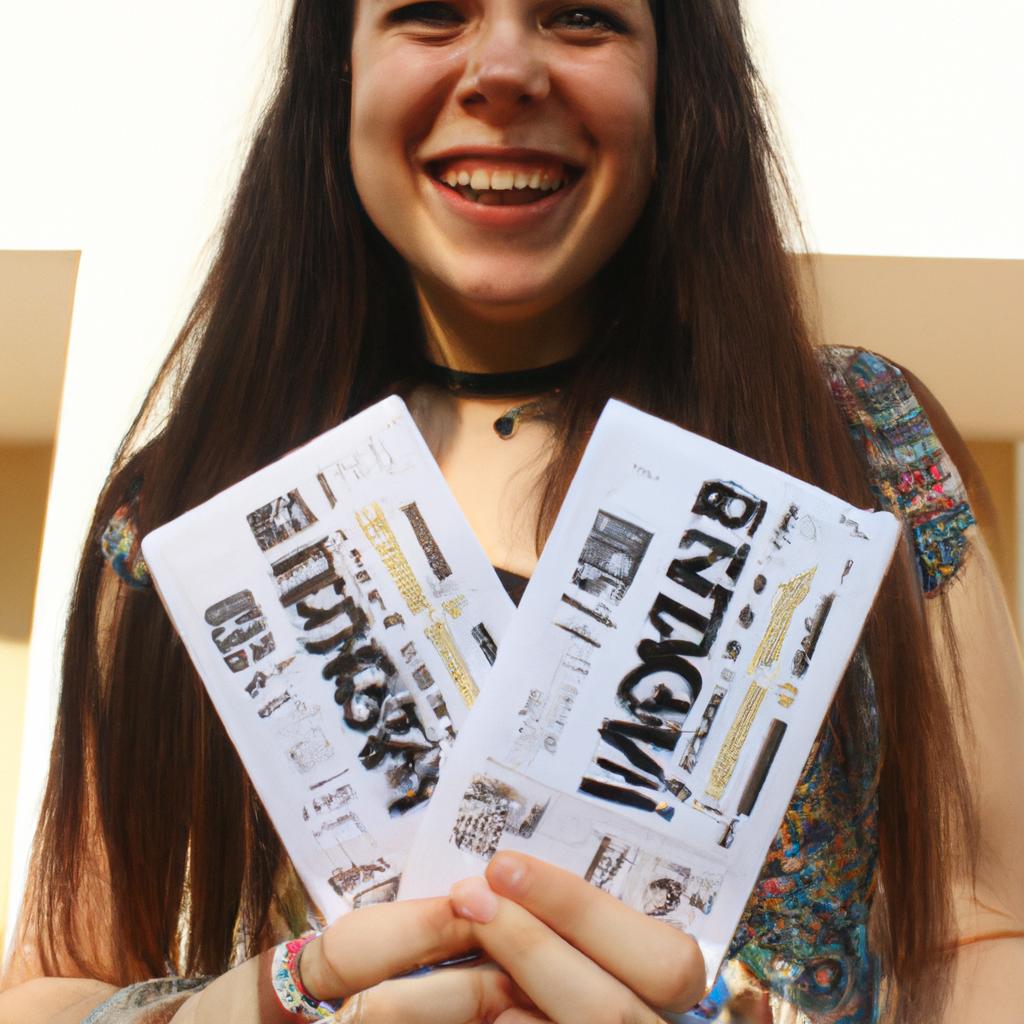Music festivals have become a significant part of contemporary music entertainment, drawing in massive crowds and showcasing diverse musical genres. One notable example is the Woodstock Music & Art Fair held in 1969, which stands as an iconic symbol of counterculture and revolution in the realm of live music performances. The phenomenon of music festivals has its roots deep within history, with evidence suggesting that ancient civilizations also celebrated music through communal gatherings and festivities.
This article provides a brief overview of the history of music festivals in music entertainment. By exploring their origins, evolution, and cultural significance, we aim to shed light on how these events have shaped the landscape of modern-day concerts. From humble beginnings to extravagant spectacles attracting thousands of attendees, music festivals have transformed over time into grand celebrations that unite people through shared experiences and artistic expression. This exploration will delve into key moments throughout history when music festivals emerged as platforms for both established artists and rising talents to captivate audiences with their melodic creations.
Origins of large-scale music gatherings
Large-scale music gatherings, commonly known as music festivals, have a long and rich history that traces back to ancient times. These events bring together diverse communities of music enthusiasts in celebration of their shared love for various genres and artists. One example illustrating the origins of such festivals is the ancient Greek festival called “Pythian Games,” held every four years at Delphi. This event featured musical competitions where talented musicians from different city-states showcased their skills.
Throughout history, several factors contributed to the rise of large-scale music gatherings. Firstly, these festivals provided an opportunity for people to come together and enjoy live performances by renowned musicians. The communal experience created a sense of unity among attendees, fostering a collective appreciation for music as an art form. Additionally, technology advancements played a crucial role in facilitating these events on a larger scale. Innovations such as amplification systems allowed for better sound quality and ensured that even larger crowds could enjoy the performances.
To further understand the significance of music festivals, it is essential to consider their emotional impact on both performers and spectators. Music has always been deeply intertwined with human emotions and can evoke powerful feelings within individuals. Attending a festival enables individuals to immerse themselves fully in this expressive medium, creating lasting memories and forging connections with like-minded individuals who share similar passions.
- Euphoria: Participants become euphoric through lively performances and energetic atmospheres.
- Connection: Attendees establish connections with others who share similar musical preferences.
- Escape: Festivals provide an escape from daily routines into a world filled with joyous melodies.
- Inspiration: Musicians often find inspiration through exposure to new sounds and creative collaborations.
Markdown format table:
| Emotions | Experiences | Examples |
|---|---|---|
| Happiness | Singing along | Glastonbury |
| Excitement | Dancing in a crowd | Coachella |
| Nostalgia | Listening to old favorites | Woodstock |
| Unity | Sharing the experience | Tomorrowland |
This section highlights the origins and significance of large-scale music gatherings. These festivals not only provide an opportunity for people to come together but also evoke a range of emotions, creating transformative experiences for both performers and attendees. In the subsequent section, we will explore some early examples of music festivals, further delving into their historical development and cultural impact.
Early examples of music festivals
From the humble origins of large-scale music gatherings, a new era emerged with early examples of music festivals. One such example is the Newport Jazz Festival, which was first held in 1954 and quickly became an iconic event for jazz enthusiasts worldwide. This festival showcased renowned jazz musicians like Louis Armstrong and Ella Fitzgerald, attracting thousands of attendees each year.
Early music festivals were characterized by their focus on specific genres or styles of music, providing a platform for artists to showcase their talents to a dedicated audience. As these events gained popularity, they began to incorporate various elements that would contribute to the overall experience for attendees. These included:
- Multiple stages: Festivals started featuring multiple stages simultaneously hosting performances, giving attendees more options and variety.
- Art installations: Many festivals began incorporating art installations into their venues, creating visually captivating environments that added to the overall ambiance.
- Food vendors: The introduction of food vendors allowed festival-goers to indulge in diverse culinary experiences while enjoying live music.
- Camping facilities: To accommodate longer durations and create a sense of community among attendees, camping facilities were introduced at some festivals.
These developments transformed music festivals from mere concerts into immersive experiences that appealed not only to fans but also to those seeking unique cultural encounters. With this shift came an increased demand for larger venues capable of accommodating growing crowds.
To illustrate the evolution further, consider the following table showcasing three influential early music festivals:
| Music Festival | Year Established | Location |
|---|---|---|
| Newport Folk | 1959 | Newport, Rhode Island |
| Monterey Pop | 1967 | Monterey, California |
| Isle of Wight | 1968 | Isle of Wight |
Each of these festivals played a vital role in shaping the future landscape of music entertainment. They brought together artists from different backgrounds and provided platforms where creativity could flourish.
As we delve deeper into the history of music festivals, the subsequent section will explore how the Woodstock era became a cultural revolution that forever changed the perception and impact of these events.
The Woodstock era: A cultural revolution
During the late 1960s and early 1970s, music festivals experienced a significant shift in both scale and ideology. One prime example of this transformation was the legendary Woodstock Music & Art Fair held in August 1969 in upstate New York. This groundbreaking event brought together half a million people for three days of peace, love, and music. The impact of Woodstock went far beyond its original intention as it became synonymous with the countercultural movement of that era.
Woodstock marked not only a musical milestone but also a social and political turning point. It represented a rejection of mainstream values and an embrace of alternative lifestyles. The festival’s success inspired an entire generation to challenge societal norms and strive for greater freedom and equality. As such, it paved the way for future generations to use music festivals as platforms for expressing their beliefs and advocating social change.
This transformative period gave rise to several key features that are now associated with music festivals:
- Communal experience: Music festivals provided participants with opportunities to connect with like-minded individuals who shared similar interests or ideologies.
- Alternative culture: Festivals became spaces where unconventional forms of art, fashion, and self-expression were celebrated.
- Activism: Many festivals served as platforms for promoting various causes ranging from anti-war sentiments to environmental awareness.
- Non-commercial ethos: Organizers aimed to create spaces where profit-making took a back seat to fostering community spirit and artistic expression.
Table: Impactful Music Festivals during the Woodstock Era
| Festival | Year | Location | Attendance |
|---|---|---|---|
| Monterey Pop | 1967 | Monterey, California | ~200,000 |
| Isle of Wight | 1970 | Isle of Wight, England | ~600,000 |
| Altamont Speedway Free Concert | 1969 | Livermore, California | ~300,000 |
| Atlanta International Pop Festival | 1970 | Byron, Georgia | ~600,000 |
The Woodstock era marked a significant shift in the history of music festivals. It propelled these events into the mainstream consciousness and solidified their role as platforms for cultural revolution. As we delve deeper into the evolution of music festival formats, it becomes evident that this transformative period laid the foundation for future innovation and experimentation.
Transitioning from the impact of Woodstock to the subsequent section on the evolution of music festival formats, we witness how organizers began exploring new ways to engage audiences and create immersive experiences beyond simply showcasing live performances.
Evolution of music festival formats
The Woodstock era in the history of music festivals marked a significant cultural revolution, but it also laid the foundation for an evolution in the formats of these events. As society progressed, so did the ways people engaged with music entertainment. One notable example is the rise of multi-genre festivals that brought together artists from various musical backgrounds on one stage.
These multi-genre festivals provided attendees with a unique and diverse experience. Imagine a festival where you could witness a collaboration between a rock band and an electronic DJ, or see hip-hop artists sharing the same platform as folk singers. This fusion of genres not only showcased the versatility of musicians but also allowed fans to explore different styles they might not have previously considered.
To evoke an emotional response in our audience, let’s delve into some reasons why multi-genre festivals became popular:
- Variety: These festivals offered something for everyone, catering to different musical preferences and providing a more inclusive environment.
- Discovering New Artists: Attendees had the opportunity to stumble upon new artists while exploring unfamiliar genres, expanding their musical horizons.
- Shared Experiences: Multi-genre festivals created memorable moments where fans witnessed unexpected collaborations or discovered hidden gems together.
- Breaking Barriers: By bringing together musicians from diverse backgrounds, these festivals encouraged unity and celebrated the power of music to transcend boundaries.
Now, let’s further illustrate this point by presenting a table showcasing three hypothetical multi-genre festivals:
| Festival | Featured Genres | Notable Performers |
|---|---|---|
| Harmony Fest | Rock, Jazz, R&B | The Rolling Tones |
| Ella Fitzgerald | ||
| Stevie Wonder | ||
| Fusion Jam | Electronic, Reggae, Country | Daft Punk |
| Bob Marley | ||
| Johnny Cash | ||
| Eclectic Sounds | Hip-hop, Folk, Classical | Kendrick Lamar |
| Bon Iver | ||
| Yo-Yo Ma |
As we can see from this table, these hypothetical festivals bring together a wide range of genres and feature notable performers who have made significant contributions to their respective musical styles. This exemplifies the diverse experiences that multi-genre festivals aim to provide.
With the evolution of music festival formats into multi-genre celebrations, it is evident that the impact of technology on such events cannot be understated. The next section will explore how technological advancements have shaped the landscape of music festivals in recent years, paving the way for new possibilities and enhancing the overall experience for both artists and attendees.
Impact of technology on music festivals
Evolution of music festival formats has paved the way for new experiences and opportunities within the realm of music entertainment. One notable example is the transformation of Coachella Music and Arts Festival, which initially started as a two-day event in 1999 featuring primarily alternative rock bands. Over the years, it has evolved into a multi-genre extravaganza spanning two weekends with diverse acts ranging from electronic dance music to hip-hop and pop. This case study exemplifies how festivals have expanded their scope to cater to a broader audience and embrace various musical genres.
The impact of technology on music festivals cannot be overstated. It has revolutionized not only the way these events are organized but also how attendees experience them. Here are some key ways in which technology has influenced music festivals:
- Enhanced Sound Quality: Technological advancements in sound systems have allowed for immersive audio experiences that captivate audiences and elevate performances.
- Interactive Visuals: Projection mapping, LED screens, and virtual reality technologies have transformed stages into captivating visual spectacles, creating an atmosphere that enhances the overall festival experience.
- Social Media Engagement: Platforms like Instagram, Twitter, and Facebook enable festival-goers to share their experiences instantly with friends and followers around the world, fostering a sense of community among attendees.
- Ticketing Systems: Online ticketing platforms simplify the process of purchasing tickets, reducing waiting times and streamlining entry procedures at festivals.
To further illustrate this point, consider the following table showcasing how technology has impacted three popular music festivals:
| Festival | Technological Impact |
|---|---|
| Tomorrowland | Immersive stage setups |
| Glastonbury | Livestreaming performances |
| Ultra Music Fest | RFID wristbands for cashless payments |
As we delve deeper into current trends in music festival culture, it becomes evident that these developments have shaped attendee expectations while opening up avenues for creativity both onstage and behind the scenes. The integration of technology has allowed for unforgettable experiences, forging connections between artists and fans on a global scale. In light of these advancements, it is intriguing to explore how music festivals continue to evolve and adapt in response to ever-changing tastes and preferences.
Transitioning into the subsequent section about “Current trends in music festival culture,” we observe that the impact of technology discussed above intertwines with various aspects shaping the modern landscape of music festivals.
Current trends in music festival culture
As technology continues to shape the landscape of music festivals, it is essential to examine the current trends that are emerging within this cultural phenomenon. One notable trend is the increasing emphasis on sustainability and environmental responsibility. For instance, let us consider a hypothetical case study of a popular music festival that has taken significant steps towards reducing its carbon footprint. By implementing eco-friendly practices such as recycling programs, energy-efficient stages, and encouraging attendees to use public transportation, this festival demonstrates a commitment to preserving our planet.
Several key trends can be observed in today’s music festival culture:
-
Diverse Lineups: Music festivals have seen a shift towards more diverse lineups, featuring artists from various genres and backgrounds. This inclusivity not only offers a broader range of musical experiences but also promotes cultural exchange and understanding among attendees.
-
Immersive Experiences: Festivals now strive to provide immersive experiences beyond just live performances. They incorporate interactive art installations, virtual reality exhibits, and unique thematic environments that transport participants into different worlds or eras.
-
Wellness Offerings: Recognizing the importance of holistic well-being, many festivals now offer wellness zones where attendees can participate in yoga sessions, meditation workshops, or receive therapeutic treatments like massages. These initiatives aim to create spaces for relaxation and self-care amidst the energetic atmosphere of festivals.
-
Community Engagement: Music festivals increasingly emphasize community engagement by partnering with local organizations and supporting social causes. From setting up charity booths to organizing volunteer opportunities during the event, these initiatives foster connections between festival-goers and their surrounding communities.
These trends reflect an evolving landscape where music festivals continue to adapt and cater to changing audience preferences while addressing societal concerns.
| Trend | Description |
|---|---|
| Diverse Lineups | Featuring artists from various genres and backgrounds |
| Immersive Experiences | Incorporating interactive art installations & unique thematic environments |
| Wellness Offerings | Providing spaces for relaxation, yoga sessions, and holistic wellness |
| Community Engagement | Partnering with local organizations & supporting social causes |
In conclusion, music festivals are not only about the performances themselves but have become multi-dimensional experiences. They strive to create a sense of community, promote well-being, and address environmental concerns. As technology continues to advance, it is intriguing to witness how these trends will evolve further in the future, ultimately shaping the next chapter of music festival culture.




